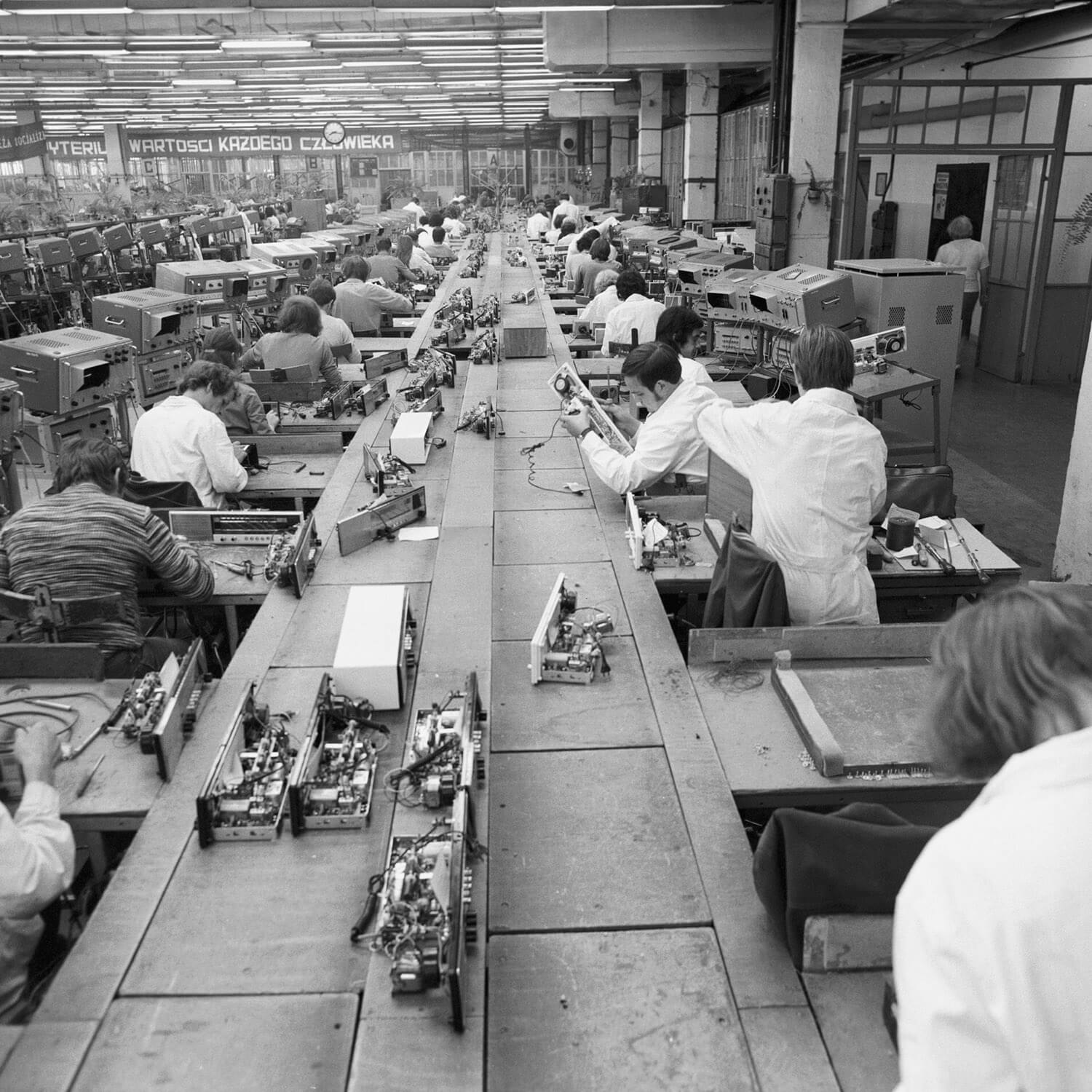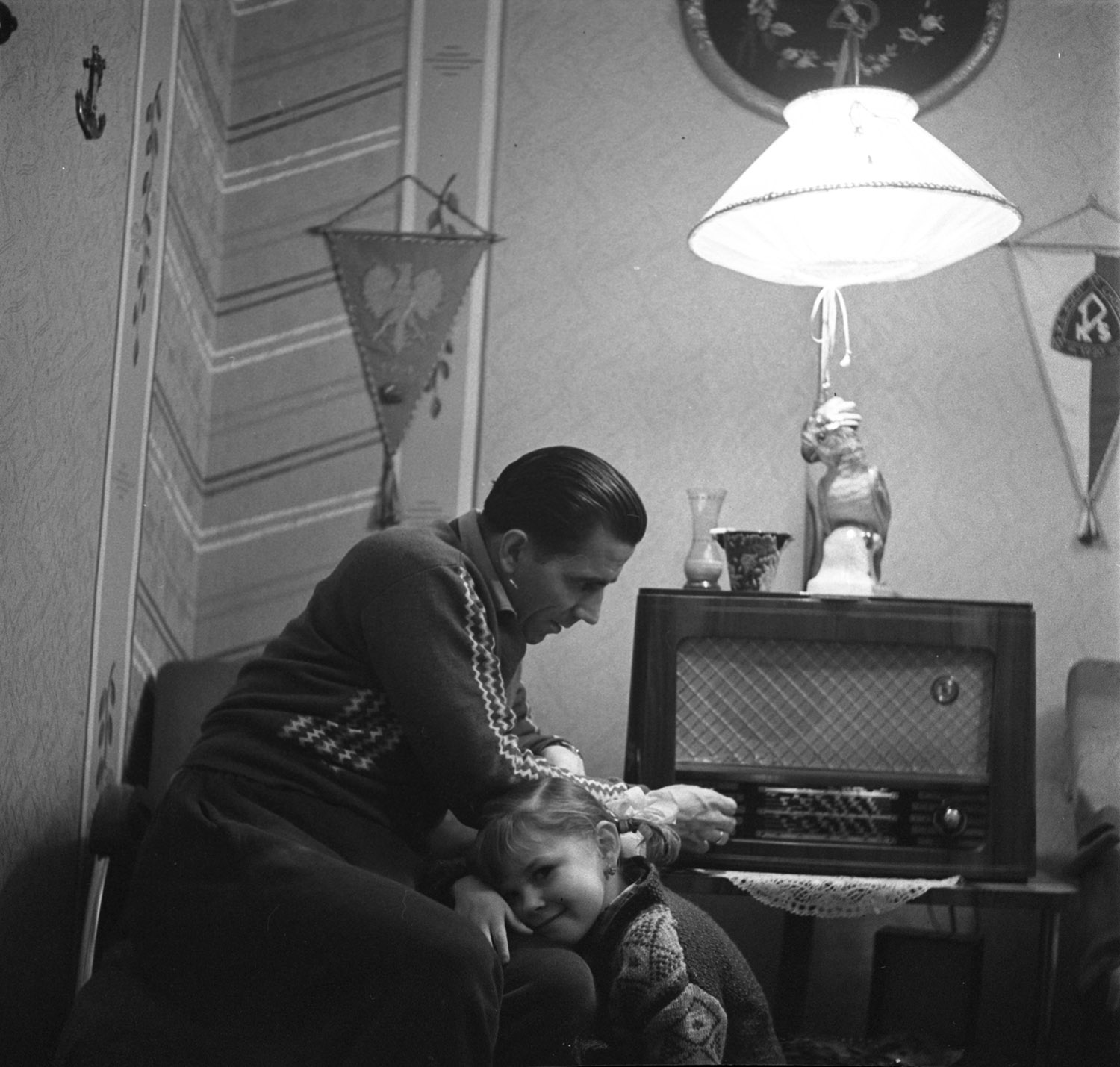Kurant radio with a clock︎
inventory No. MIM 311/V/51; created: 1963; manufacturer: Zakłady Radiowe Diora; location: Dzierżoniów, Poland; materials: plastics, steel, aluminium, copper, bakelite, rubber; dimensions [mm]: H 175, W 395, D 230.


The Kurant radio set by Diora was manufactured between 1965 and 1967. A clock was installed in the set which permitted one to turn the radio on or off at a specified time. The set received programmes on short, medium, and long waves.
The Diora plant was built at the site of a former German radio equipment factory in the town of Dierżoniów (Lower Silesia). After Polish administration took over the town, and with the help of pre-war engineers, it was possible to quickly bring the factory back to life, initially to manufacture German radio sets. At the beginning of its operation, the Polish plant employed only eight pre-war engineers, however, the staff amounted to as many as 1,400 people by 1948. The first, fully Polish radio set, the ‘Pionier’, was eventually manufactured there. Its manufacturing was commissioned in 1948.
The decade of the 1960s, when Kurant radios were manufactured, was an important period in the history of the plant. The growth of the factory permitted the production of radio sets for export. The authorities had planned to modernize the Diora plant, but their plans were frustrated by a fire in 1964. The fire consumed documentation and plans required for production, amongst many other things. The most important documents were recreated within 24 hours. Instead of shutting down the plant, it was decided to move production to one of the warehouses. The employees worked longer hours, for example, collectively putting in 50 000 hours of community service (#community_service). In 1966, after the Diora plant was reconstructed following the fire, radio set production was moved from the Kasprzak factory in Warsaw, to the plant in Dzierżoniów. The outcome was a focus upon product unification instead of innovation.
After the political transformation, the State Enterprise ‘Diora’ was transformed into a joint-stock company. The plant experienced several layoffs (#unemployment), and in 2001, the company filed for bankruptcy, the proceedings of which were completed in 2006.
At the end of the 1940s, the pre-war engineers and academics who had helped to restart the plant, began to transfer to the university world. This provided an opportunity for new employees to shine and increased the demand for specialists. After an initial staffing problem in the 1950s, which was associated with the outflow of the intelligentsia from the town (#migrations), the situation improved in the 1960s. The plant promoted the education of its employees (#education), who had a chance to complete basic education, start education in extramural secondary high schools or benefit from cooperation with the University of Wrocław and the Silesian University of Technology. Each educational promotion of a Diora employee was celebrated in a festive atmosphere with ceremonies.
From 1950, Diora plant workers had access to their own infirmary (then an outpatient clinic). The plant organized holidays and summer camps for its employees and their families. A factory club, which integrated Diora personnel, had functioned at the plant (#break_at_work). Plant employees were also entitled to worker’s accommodation and long-term loans for house construction (#work_conditions #socialisation_at_work).
Up until 1947, the parts in the plant were assembled at a single table using a radio set line, as manufacturing stages were not divided between workers at the time. In the mid-1950s, the production process was accelerated (#pace of work) owing to a system based on four rubber conveyors (#automation). This raised concerns associated with failure to keep up with machine speed. In 1966, rubber conveyors were replaced with conveyor transporters, which gave rise to worker protests, whereby heavier female workers demonstratively blocked their work stations (#work_in_tight_spaces #employee_segregation_due_to_gender). Due to the later production modernization, some female workers had to change the departments they worked for. After years of work, their sight was too bad and their manual skills poor (occupational_disease).
︎
The Diora plant was built at the site of a former German radio equipment factory in the town of Dierżoniów (Lower Silesia). After Polish administration took over the town, and with the help of pre-war engineers, it was possible to quickly bring the factory back to life, initially to manufacture German radio sets. At the beginning of its operation, the Polish plant employed only eight pre-war engineers, however, the staff amounted to as many as 1,400 people by 1948. The first, fully Polish radio set, the ‘Pionier’, was eventually manufactured there. Its manufacturing was commissioned in 1948.
The decade of the 1960s, when Kurant radios were manufactured, was an important period in the history of the plant. The growth of the factory permitted the production of radio sets for export. The authorities had planned to modernize the Diora plant, but their plans were frustrated by a fire in 1964. The fire consumed documentation and plans required for production, amongst many other things. The most important documents were recreated within 24 hours. Instead of shutting down the plant, it was decided to move production to one of the warehouses. The employees worked longer hours, for example, collectively putting in 50 000 hours of community service (#community_service). In 1966, after the Diora plant was reconstructed following the fire, radio set production was moved from the Kasprzak factory in Warsaw, to the plant in Dzierżoniów. The outcome was a focus upon product unification instead of innovation.
After the political transformation, the State Enterprise ‘Diora’ was transformed into a joint-stock company. The plant experienced several layoffs (#unemployment), and in 2001, the company filed for bankruptcy, the proceedings of which were completed in 2006.
At the end of the 1940s, the pre-war engineers and academics who had helped to restart the plant, began to transfer to the university world. This provided an opportunity for new employees to shine and increased the demand for specialists. After an initial staffing problem in the 1950s, which was associated with the outflow of the intelligentsia from the town (#migrations), the situation improved in the 1960s. The plant promoted the education of its employees (#education), who had a chance to complete basic education, start education in extramural secondary high schools or benefit from cooperation with the University of Wrocław and the Silesian University of Technology. Each educational promotion of a Diora employee was celebrated in a festive atmosphere with ceremonies.
From 1950, Diora plant workers had access to their own infirmary (then an outpatient clinic). The plant organized holidays and summer camps for its employees and their families. A factory club, which integrated Diora personnel, had functioned at the plant (#break_at_work). Plant employees were also entitled to worker’s accommodation and long-term loans for house construction (#work_conditions #socialisation_at_work).
Up until 1947, the parts in the plant were assembled at a single table using a radio set line, as manufacturing stages were not divided between workers at the time. In the mid-1950s, the production process was accelerated (#pace of work) owing to a system based on four rubber conveyors (#automation). This raised concerns associated with failure to keep up with machine speed. In 1966, rubber conveyors were replaced with conveyor transporters, which gave rise to worker protests, whereby heavier female workers demonstratively blocked their work stations (#work_in_tight_spaces #employee_segregation_due_to_gender). Due to the later production modernization, some female workers had to change the departments they worked for. After years of work, their sight was too bad and their manual skills poor (occupational_disease).
︎